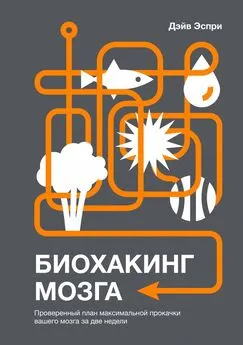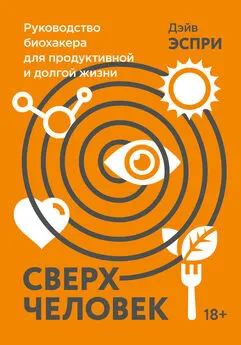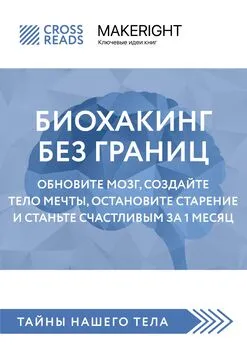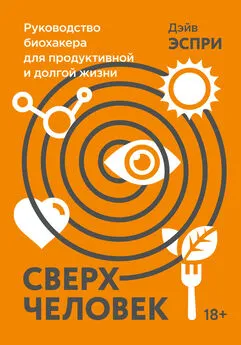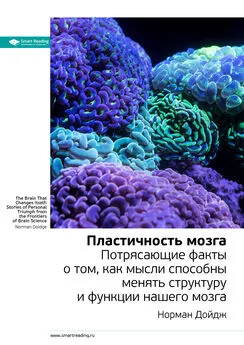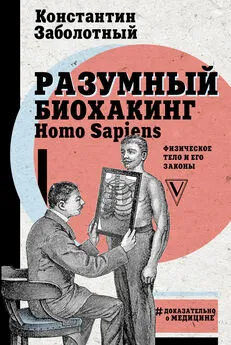Дэйв Эспри - Биохакинг мозга
- Название:Биохакинг мозга
- Автор:
- Жанр:
- Издательство:Манн, Иванов и Фербер
- Год:2018
- Город:Москва
- ISBN:9785001176312
- Рейтинг:
- Избранное:Добавить в избранное
-
Отзывы:
-
Ваша оценка:
Дэйв Эспри - Биохакинг мозга краткое содержание
Представили?
Это реально. В этой книге вы найдете эффективную программу прокачки организма. Вы узнаете, какие продукты должны присутствовать в вашем рационе и каких следует избегать, какие виды физической активности необходимо добавить в распорядок дня, как правильно организовать рабочее пространство, а еще о добавках, детоксе для дома и тела, медитации и дыхательных практиках, позволяющих мозгу всего за две недели заработать на все 100 %.
Биохакинг мозга - читать онлайн бесплатно ознакомительный отрывок
Интервал:
Закладка:
85
Jeremy P. E. Spencer, “Interactions of Flavonoids and Their Metabolites with Cell Signaling Cascades,” in Nutrigenomics, ed. Gerald Rimbach, Jürgen Fuchs, and Lester Packer (CRC Press, 2005), 353–378, http://www.crcnetbase.com/doi/abs/10.1201/9781420028096.ch17.
86
Jeremy P. E. Spencer, “Interactions of Flavonoids and Their Metabolites with Cell Signaling Cascades,” in Nutrigenomics, ed. Gerald Rimbach, Jürgen Fuchs, and Lester Packer (CRC Press, 2005), 353–378, http://www.crcnetbase.com/doi/abs/10.1201/9781420028096.ch17.
87
Massimo D’Archivio et al., “Bioavailability of the Polyphenols: Status and Controversies,” International Journal of Molecular Sciences 11, no. 4 (March 31, 2010): 1321–1342, DOI: 10.3390/ijms11041321.
88
Jane V. Higdon and Balz Frei, “Coffee and Health: A Review of Recent Human Research,” Critical Reviews in Food Science and Nutrition 46, no. 2 (2006): 101–123, DOI: 10.1080/10408390500400009.
89
Kenneth J. Mukamal et al., “Coffee Consumption and Mortality after Acute Myocardial Infarction: The Stockholm Heart Epidemiology Program,” American Heart Journal 157, no. 3 (March 2009): 495–501, DOI: 10.1016/j.ahj.2008.11.009.
90
Harumi Uto-Kondo et al., “Coffee Consumption Enhances High-Density Lipoprotein-Mediated Cholesterol Efflux in Macrophages,” Circulation Research 106, no. 4 (March 5, 2010): 779–787, DOI: 10.1161/CIRCRESAHA.109.206615.
91
Yi-Fang Chu et al., “Roasted Coffees High in Lipophilic Antioxidants and Chlorogenic Acid Lactones Are More Neuroprotective Than Green Coffees,” Journal of Agricultural and Food Chemistry 57, no. 20 (October 28, 2009): 9801–9808, DOI: 10.1021/jf902095z.
92
Esther Lopez-Garcia et al., “The Relationship of Coffee Consumption with Mortality,” Annals of Internal Medicine 148, no. 12 (June 17, 2008): 904–914.
93
Esther Lopez-Garcia et al., “Coffee Consumption and Risk of Stroke in Women,” Circulation 119, no. 8 (March 3, 2009): 1116–1123, DOI: 10.1161/CIRCULATIONAHA.108.826164.
94
W. L. Zhang et al., “Coffee Consumption and Risk of Cardiovascular Events and All-Cause Mortality among Women with Type 2 Diabetes,” Diabetologia 52, no. 5 (May 2009): 810–817, DOI: 10.1007/s00125-009-1311-1.
95
D. D. Mellor et al., “High-Cocoa Polyphenol-Rich Chocolate Improves HDL Cholesterol in Type 2 Diabetes Patients,” Diabetic Medicine: A Journal of the British Diabetic Association 27, no. 11 (November 2010): 1318–1321.
96
M. Sánchez-Hervás et al., “Mycobiota and Mycotoxin Producing Fungi from Cocoa Beans,” International Journal of Food Microbiology 125, no. 3 (July 31, 2008): 336–340, DOI: 10.1016/j.ijfoodmicro.2008.04.021.
97
Mark A. Wilson et al., “Blueberry Polyphenols Increase Lifespan and Thermotolerance in Caenorhabditis Elegans,” Aging Cell 5, no. 1 (February 2006): 59–68, DOI: 10.1111/j.1474–9726.2006.00192.x.
98
Ana Rodriguez-Mateos et al., “Intake and Time Dependence of Blueberry Flavonoid-Induced Improvements in Vascular Function: A Randomized, Controlled, Double-Blind, Crossover Intervention Study with Mechanistic Insights into Biological Activity,” American Journal of Clinical Nutrition 98, no. 5 (November 2013): 1179–1191, DOI: 10.3945/ajcn.113.066639.
99
Navindra P. Seeram, Rupo Lee, and David Heber, “Bioavailability of Ellagic Acid in Human Plasma After Consumption of Ellagitannins from Pomegranate (Punica Granatum L.) Juice,” Clinica Chimica Acta; International Journal of Clinical Chemistry 348, no. 1–2 (October 2004): 63–68, DOI: 10.1016/j.cccn.2004.04.029.
100
Olga Vitseva et al., “Grape Seed and Skin Extracts Inhibit Platelet Function and Release of Reactive Oxygen Intermediates,” Journal of Cardiovascular Pharmacology 46, no. 4 (October 2005): 445–451.
101
Debasis Bagchi et al., “Molecular Mechanisms of Cardioprotection by a Novel Grape Seed Proanthocyanidin Extract,” Mutation Research 523–524 (March 2003): 87–97.
102
David Pajuelo et al., “Chronic Dietary Supplementation of Proanthocyanidins Corrects the Mitochondrial Dysfunction of Brown Adipose Tissue Caused by Diet-Induced Obesity in Wistar Rats,” British Journal of Nutrition 107, no. 2 (January 2012): 170–178, DOI: 10.1017/S0007114511002728.
103
Junli Zhen et al., “Effects of Grape Seed Proanthocyanidin Extract on Pentylenetetrazole-Induced Kindling and Associated Cognitive Impairment in Rats,” International Journal of Molecular Medicine 34, no. 2 (August 2014): 391–398, DOI: 10.3892/ijmm.2014.1796.
104
Valerie Desquiret-Dumas et al., “Resveratrol Induces a Mitochondrial Complex I Dependent Increase in NADH Oxidation Responsible for Sirtuin Activation in Liver Cells,” Journal of Biological Chemistry (October 31, 2013), DOI: 10.1074/jbc.M113.466490.
105
Marie Lagouge et al., “Resveratrol Improves Mitochondrial Function and Protects Against Metabolic Disease by Activating SIRT1 and PGC-1 alpha,” Cell 127, no. 6 (December 15, 2006): 1109–1122, DOI: 10.1016/j.cell.2006.11.013.
106
Richard D. Semba, Luigi Ferrucci, and Benedetta Bartali, “Resveratrol Levels and All-Cause Mortality in Older Community-Dwelling Adults,” JAMA Internal Medicine 174, no. 7 (July 1, 2014): 1077–1084, DOI: 10.1001/jamainternmed.2014.1582.
107
Tamara Shiner et al., “Dopamine and Performance in a Reinforcement Learning Task: Evidence from Parkinson’s Disease,” Brain: A Journal of Neurology 135, Pt 6 (June 2012): 1871–1883, DOI: 10.1093/brain/aws083.
108
Paul T. Francis et al., “The Cholinergic Hypothesis of Alzheimer’s Disease: A Review of Progress,” Journal of Neurology, Neurosurgery and Psychiatry 66, no. 2 (February 1, 1999): 137–147, DOI: 10.1136/jnnp.66.2.137.
109
Richard H. Hall, “Neurotransmitters and Sleep” (Lesson outline, Missouri University of Science and Technology, 1998), http://web.mst.edu/~rhall/neuroscience/03_sleep/sleepneuro.pdf.
110
DL-фенилаланин (DLPA) — одна из незаменимых аминокислот, которая также служит в качестве строительного элемента для различных видов белков, которые производит организм человека. Прим. ред.
111
Cecilia Vitali, Cheryl L. Wellington, and Laura Calabresi, “HDL and Cholesterol Handling in the Brain,” Cardiovascular Research 103, no. 3 (August 1, 2014): 405–413, DOI: 10.1093/cvr/cvu148.
112
Meharban Singh, “Essential Fatty Acids, DHA and Human Brain,” Indian Journal of Pediatrics 72, no. 3 (March 2005): 239–242.
113
M. A. Crawford et al., “Evidence for the Unique Function of Docosahexaenoic Acid during the Evolution of the Modern Hominid Brain,” Lipids 34, no. 1 (1999): S39–S47, DOI: 10.1007/BF02562227.
114
Karin Yurko-Mauro et al., “Beneficial Effects of Docosahexaenoic Acid on Cognition in Age-Related Cognitive Decline,” Alzheimer’s and Dementia: The Journal of the Alzheimer’s Association 6, no. 6 (November 2010): 456–464, DOI: 10.1016/j.jalz.2010.01.013.
115
Dany Arsenault et al., “DHA Improves Cognition and Prevents Dysfunction of Entorhinal Cortex Neurons in 3xTg-AD Mice,” PLOS ONE 6, no. 2 (February 23, 2011): e17397, DOI: 10.1371/journal.pone.0017397.
116
Eric N. Ponnampalam, Neil J. Mann, and Andrew J. Sinclair, “Effect of Feeding Systems on Omega-3 Fatty Acids, Conjugated Linoleic Acid and Trans Fatty Acids in Australian Beef Cuts: Potential Impact on Human Health,” Asia Pacific Journal of Clinical Nutrition 15, no. 1 (2006): 21–29.
117
J. M. Leheska et al., “Effects of Conventional and Grass-Feeding Systems on the Nutrient Composition of Beef,” Journal of Animal Science 86, no. 12 (December 2008): 3575–3585, DOI: 10.2527/jas.2007–0565.
118
Gabriela Segura, “Ketogenic Diet — a Connection between Mitochondria and Diet,” DoctorMyhill, November 20, 2015, http://www.drmyhill.co.uk/wiki/Ketogenic_diet_-_a_connection_between_mitochondria_and_diet.
119
Anssi H. Manninen, “Metabolic Effects of the Very-Low-Carbohydrate Diets: Misunderstood ‘Villains’ of Human Metabolism,” Journal of the International Society of Sports Nutrition 1, no. 2 (December 31, 2004): 7–11, DOI: 10.1186/1550-2783-1-2-7.
120
R. Pasquali et al., “Effect of Dietary Carbohydrates during Hypocaloric Treatment of Obesity on Peripheral Thyroid Hormone Metabolism,” Journal of Endocrinological Investigation 5, no. 1 (February 1982): 47–52, DOI: 10.1007/BF03350482.
121
Vigen K. Babayan, “Medium Chain Length Fatty Acid Esters and Their Medical and Nutritional Applications,” Journal of the American Oil Chemists’ Society 58, no. 1 (n.d.): 49A–51A, DOI: 10.1007/BF02666072.
122
A. A. Gibson et al., “Do Ketogenic Diets Really Suppress Appetite? A Systematic Review and Meta-Analysis,” Obesity Reviews: An Official Journal of the International Association for the Study of Obesity 16, no. 1 (January 2015): 64–76, DOI: 10.1111/obr.12230.
123
Mark P. Mattson, Wenzhen Duan, and Zhihong Guo, “Meal Size and Frequency Affect Neuronal Plasticity and Vulnerability to Disease: Cellular and Molecular Mechanisms,” Journal of Neurochemistry 84, no. 3 (February 2003): 417–431.
124
Elvira Larqué et al., “Dietary Trans Fatty Acids Alter the Compositions of Microsomes and Mitochondria and the Activities of Microsome Delta6-Fatty Acid Desaturase and Glucose-6-Phosphatase in Livers of Pregnant Rats,” Journal of Nutrition 133, no. 8 (August 2003): 2526–2531.
125
Wenfeng Yu et al., “Leaky β-Oxidation of a Trans-Fatty Acid: Incomplete β-Oxidation of Elaidic Acid Is Due to the Accumulation of 5-Trans-Tetradecenoyl-Coa and Its Hydrolysis and Conversion to 5-Transtetradecenoylcarnitine in the Matrix of Rat Mitochondria,” Journal of Biological Chemistry 279, no. 50 (December 10, 2004): 52160–52167, DOI: 10.1074/jbc.M409640200.
126
Dariush Mozaffarian et al., “Dietary Intake of Trans Fatty Acids and Systemic Inflammation in Women,” American Journal of Clinical Nutrition 79, no. 4 (April 2004): 606–612.
127
Giselle S. Duarte and Adriana Farah, “Effect of Simultaneous Consumption of Milk and Coffee on Chlorogenic Acids’ Bioavailability in Humans,” Journal of Agricultural and Food Chemistry 59, no. 14 (July 27, 2011): 7925–7931, DOI: 10.1021/jf201906p.
128
Разновидность очищенного топленого масла. Масло ги отличается от других животных и растительных жиров наличием жирных кислот с короткой химической цепью. Поэтому ги под воздействием высоких температур не становится токсичным, гореть и дымиться оно начинает только после 250 °C. Прим. ред.
Читать дальшеИнтервал:
Закладка:
